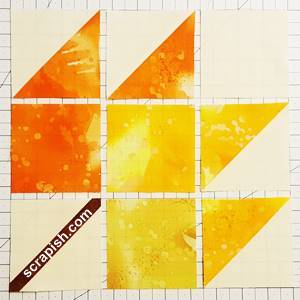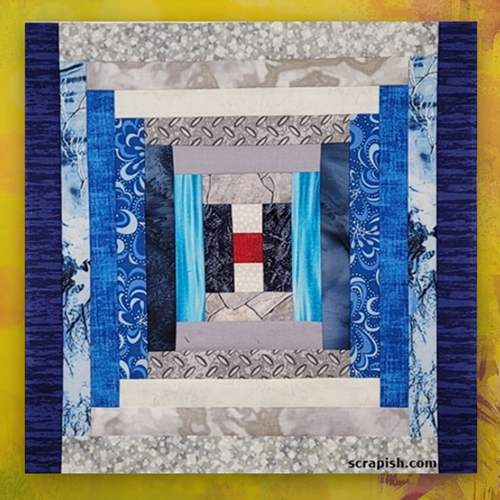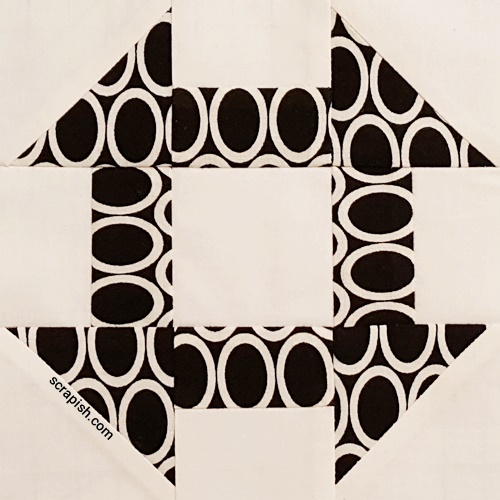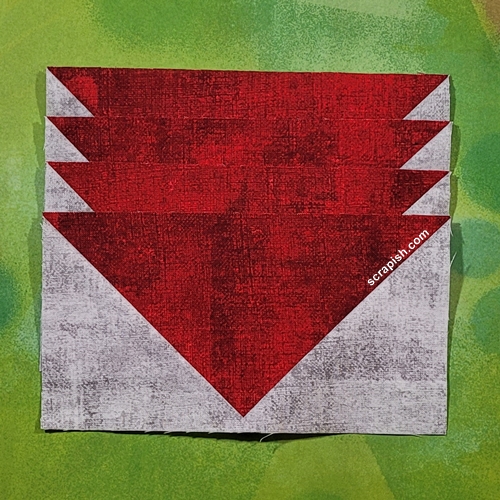Subscribe to the Quilt Blocks Digest newsletter for updates, special offers & exclusive content!
- Home
- Quilt Patterns
- Maple Leaf
Maple Leaf Quilt Pattern
This free maple leaf quilt pattern is done as a table runner using a 9 inch maple leaf quilt block. It's so easy to make!
Is your table ready for the holidays? Put this quilt on it and it will be! (Of course, you have to make it first :-0).
I designed this quilt pattern longer than usual table runners to accommodate longer tables and those that have had their table leaf added.
Finished Block Size: 9 inch
Approximate Finished Quilt Size: 19 x 61 inches
Fabrics for Quilt Top
In addition to your usual quilting supplies here are your fabric requirements (based on 40 - 42 inches usable fabric.)
Most quilt shops require you to purchase a minimum of 1/4 yard of fabric. And, if you're buying online the minimum is usually 1/2 yard.
Thus, fabric requirements are rounded to the nearest quarter yard.
1/4 yard Fabric A - 3 different prints (yellow, yellowish orange, orange)
1/4 yard Fabric B - 3 different prints (orange, reddish orange, deep red)
1 yard Fabric C - background (tan)*
1/4 yard Fabric D - stem (medium brown)
1/4 yard Fabric E - middle border (dark brown)*
*Assumes that you will piece border strips.
Backing, Binding, Batting Fabrics
Backing: 1 1/2 yards
Binding Fabric: 1/2 yard fabric
Batting: twin size (cut 23 inches X 65 inches)
Precut Friendly
This maple leaf quilt pattern is precut friendly. As an alternative you can use 6 inch strips or 5 inch charm packs. Or, just use your scraps.
Prerequisites
Maple Leaf Quilt Pattern -
Table Runner Instructions
- All seams are 1/4 inch unless otherwise noted.
- WOF = width of fabric
Fabric Cutting List
(Note: Oversized squares are used to make the HSTs, which are trimmed to size.)
From Fabric A (5 each from lighter shades of yellow, yellowish orange, orange):
cut 2 (3 1/2 inch x WOF) strips; subcut 15 (3 1/2 inch) squares
From Fabric B (3 each darker shades of reddish orange and deep red; and 5 from one shade of orange):
cut 2 (5 inch x WOF) strips; subcut 11 (5 inch) squares for HSTs (yields 1 extra HST)
From Fabric C (tan) cut:
11 (5 inch) squares for HSTs (yields 1 extra HST)
10 (3 1/2 inch) squares
From Fabric D (medium brown) cut:
5 (1 inch x 5 inch) strips for stems
Cut Fabric for Sashing
Cut 4 (2 1/2 inch x 9 1/2 inch) Fabric C (tan)
Cut Fabric for Borders
Cutting Long Strips
For the border strips, the exact measurements for the pattern are
given (if you choose not to piece) as well as the number of strips to cut to piece the long borders. This pattern calls for piecing the long border strips.
Outer Border: (2 1/2 inch x 61 1/2 inch)
Cut 4 (2 1/2 inch x WOF) Fabric C (tan) strips
Cut 2 (2 1/2 inch x 15 1/2") Fabric C (tan)
Middle Border: (2 inch x 57 1/2 inch)
Cut 4 (2 inch x WOF) Fabric E (dark brown) strips
Cut 2 (2 inch x 12 1/2 inch) Fabric E (dark brown)
Inner Border: (2 inch x 51 1/2 inch)
Cut 4 (2 inch x WOF) Fabric C (tan) strips
Cut 2 (2 inch x 12 1/2 inch) Fabric C (tan)
Make the Maple Leaf Blocks
For this maple leaf quilt pattern you'll need to make 5 (9 inch) maple leaf blocks. For each block you will need
- 4 HSTs (2 orange/tan, 1 reddish orange/tan, 1 deep red/tan)
- 4 squares (1 tan, 1 yellow, 1 yellowish orange, 1 orange)
- 1 stem (medium brown/tan)
Instructions for Steps 1 - 4 are written below without pictures. Refer to maple leaf quilt block pattern to see step by step pictures of how to make the block together.
Step 1 Make HSTs
Using the 5 inch squares in fabrics B (three darker shades of orange, reddish orange, deep red) and C (tan) make 20 half square triangles (HSTs).
Use a pencil to draw a diagonal line from corner to corner on the wrong side of the 10 - 6 inch tan (fabric C) squares.
With right sides together and fabric C on top, pair one fabric C square and one fabric B square.
Stitch a 1/4 inch seam on both sides of the marked line.
Use a rotary cutter to cut the square apart on the marked diagonal line.
Press seam toward fabric A.
Trim HSTs to 3 1/2 inches.
Step 2 Make Stems
Using fabrics C (tan) and D (medium brown) make 5 stem units.
Cut one background square (fabric C) in half diagonally from corner to corner.
Insert a strip for the stem (fabric D) between the two triangles.
With right sides together, pin the longest (bias edge) of one cut triangle to the long edge of the strip. Sew a 1/4 inch seam.
Finger press the triangle away from the stem.
Pin the second cut triangle to the opposite side of the strip and sew a 1/4 inch seam.
Finger press the second triangle away from the stem.
On the backside of the stem unit press both seams open.
Trim the stem patch unit to 3 1/2 inches square.
Repeat 4 more times for a total of 5 stem units.
Step 3 Layout Block
Near your sewing machine layout the units for each maple leaf quilt pattern block in a 9 patch grid as shown.

Step 4a Sew Units of Each Row
Sew the units of Row 1 together. Press seam inward towards column 2.
Sew the units of Row 2 together. Press seam outward towards columns 1 and 3
Sew the units of Row 3 together. Press seam inward towards column 2.
Step 4b Sew Rows Together
Sew Row 2 to Row 1. Press seam open.
Sew Row 3 to Row 2. Press seam open.
Step 5 Trim Blocks
Trim the blocks to size, in this pattern 9 1/2 inches square. If your blocks are short of being 9 1/2 inches square, simply trim them all a little smaller and to the same size.
Assemble Quilt Top
 quilt assembly diagram
quilt assembly diagramRefer to the maple leaf quilt pattern quilt assembly diagram.
Step 5a Orient the maple leaf blocks as shown in quilt assembly diagram.
Attach one sashing strip (S1, S2, S3, S4) to the bottom of each maple leaf quilt block (B1, B2, B3, B4). Press seams toward sashing strips.
Step 5b Stitch the maple leaf/sashing strip units together:
Starting with maple leaf B1/S1 unit, stitch the bottom of the sashing strip S1 to the top of the next maple leaf block.
Repeat until all five blocks units are sewn together into one main quilt column.
Press seams toward sashing strips.
Step 5c Stitch 2 (2 inch x WOF) strips end to end with a 1/4 seam. Press seams open. Attach long inner border strips to the main quilt column as noted on the quilt assembly diagram. Trim border strips to size.
Attach short inner border strips to the main quilt column.
Press seams toward border strips.
Step 5d Attach short middle border strips to the inner border as noted on the quilt assembly diagram.
Stitch 2 (2 inch x WOF) strips end to end with a 1/4 seam. Press seams open. Attach long middle border strips to the main quilt column as noted on the quilt assembly diagram. Trim border strips to size.
Press seams toward border strips.
Step 5e Attach short outer border strips to the middle border as noted on the quilt assembly diagram.
Stitch 2 (2 1/2 inch x WOF) strips end to end with a 1/4 seam. Press seams open. Attach long outer border strips to the main quilt column as noted on the quilt assembly diagram. Trim border strips to size.
Press seams toward border strips.
Finishing the Maple Leaf Quilt Pattern
Batting
Batting: twin size (cut 23 inches X 65 inches)
The length of this quilt falls between crib size and twin size packaged batting.
If you want one length of batting buy the twin size and cut it to the the above size. You will have a lot of batting left over.
Alternatively, you can purchase packaged crib size batting and cut one long piece the length of the batting and then cut a small piece to get the length measurement indicated above.
You can attach the two pieces by placing them and to end and use adhesive fusible tape to join the ends. Or, slightly overlap them and basted them together with needle and thread.
Or, buy your batting from the bolt.
Backing
Backing: 1 1/2 yards (need a 27 inch X 69 inch strip)
Cut 1 (27 inch x WOF) strip, yielding 2 (27 inch x WOF) strips.
Unfold the 2 strips and using a 1/2 inch seam allowance along the shortest length, sew the two halves together end to end. Use the resulting backing strip as is or trim to 69 inches in length.
Press the seam open.
Make the Quilt Sandwich
Put the quilt sandwich together by layering in this order the backing, batting and quilt top. Pin baste the three layers together.
Quilt the Maple Leaf Quilt Pattern
Now quilt the three layers.
May I suggest a straight line quilting pattern of diagonal lines, first going from left to right and then going from right to left of the quilt. Make the grid lines about 1 1/2 to 2 inches apart.
Did you expect the abominable 'quilt as desired'? :-). And of course you can do that!
Bind the Quilt
Binding Fabric: 1/2 yard fabric
From the half yard of fabric cut 5 (2 1/2 x 40 inch) strips and join to make a single long binding strip. (This pattern assumes you know how to bind, but binding instructions will be posted to the site at a later time.)
Maple Leaf Quilt Pattern Complete
Your new table runner made from this maple leaf quilt pattern is ready to adorn your table! (After a washing of course.)
The maple leaf evokes images of fall or Thanksgiving. But you can easily change the colors to make a runner to use on other holidays such as Christmas, Easter, the 4th of July or even Halloween.
To make this quilt modern or contemporary use solid, mottled or tone on tone fabrics in a single color, even the stem.
Raid your stash to make this maple leaf quilt pattern your own. But most of all have fun!
Subscribe to the Quilt Blocks Digest newsletter for updates, special offers & exclusive content!
You will receive an email asking you to confirm your consent to subscribe. You must click on the confirmation link contained in that email in order to be subscribed and receive emails.
Your email address is never shared. Unsubscribe any time.






